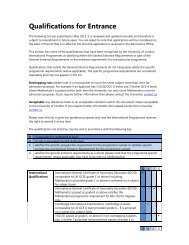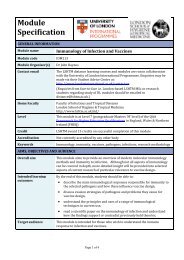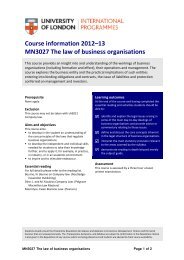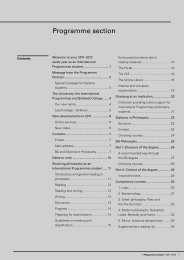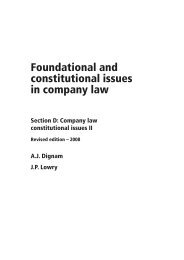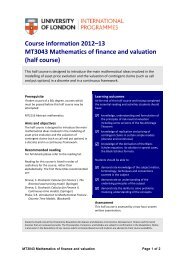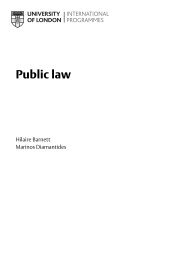Introduction to computer systems architecture and programming
Introduction to computer systems architecture and programming
Introduction to computer systems architecture and programming
You also want an ePaper? Increase the reach of your titles
YUMPU automatically turns print PDFs into web optimized ePapers that Google loves.
168 <strong>Introduction</strong> <strong>to</strong> <strong>computer</strong> <strong>systems</strong> <strong>architecture</strong> <strong>and</strong> <strong>programming</strong><br />
34<br />
The instruction is then decoded <strong>and</strong> executed by the processor. This may<br />
involve actions such as initiating a certain circuitry in the arithmetic/logic<br />
unit or sending signals <strong>to</strong> the main memory <strong>to</strong> load data in<strong>to</strong> a certain<br />
register.<br />
Once the execution of the instruction has been completed, the next cycle<br />
starts again with fetching the next instruction.<br />
Reading<br />
Now read Brookshear (2009) Chapter 2, Sections 2.1–2.3.<br />
Communication with peripherals – the controller<br />
The section above has investigated the communication within the CPU <strong>and</strong><br />
between the CPU <strong>and</strong> its main memory. Obviously, communication also<br />
takes place between the <strong>computer</strong> <strong>and</strong> many other input/output (I/O)<br />
devices (peripherals) (for example, the screen, the keyboard, the printer,<br />
an external hard drive, a digital camera, etc.). Each of these peripherals is<br />
linked <strong>to</strong> the <strong>computer</strong>’s bus through a controller.<br />
The controller generally constitutes a small <strong>computer</strong> in itself with<br />
its own functions <strong>and</strong> temporary memory (buffer) for the data that is<br />
sent or received. The controller is entirely devoted <strong>to</strong> managing the<br />
communication with the peripherals via the bus. Communication is<br />
supported by use of interrupts (Reynolds <strong>and</strong> Tymann 2008). When a<br />
program calls for output, for example, the relevant data is moved in<strong>to</strong> the<br />
buffer of the controller <strong>and</strong> the controller is instructed <strong>to</strong> start the output<br />
operation. After completion, the controller sends an interrupt <strong>to</strong> notify<br />
the main <strong>computer</strong> that it is ready for further output/action, <strong>and</strong> the<br />
original program can send further data.<br />
The development of st<strong>and</strong>ards has led <strong>to</strong> controllers such as the USB<br />
(universal serial bus) controllers <strong>and</strong> FireWire that allow the use of a<br />
single controller for a wide range of different devices (Brookshear 2009).<br />
Some of these controllers communicate with the CPU as if they<br />
were memory addresses (i.e. data can be LOADED <strong>and</strong> STORED<br />
via the controller). Obviously, in order for this not <strong>to</strong> interfere with<br />
communication with the main memory, a set of addresses is reserved for<br />
the controller. This approach is referred <strong>to</strong> as memory-mapped I/O<br />
(Reynolds <strong>and</strong> Tymann 2008). Alternatively, a <strong>computer</strong> may have special<br />
instructions that direct the transfer of the data <strong>to</strong> <strong>and</strong> from the controller<br />
(I/O instructions, such as ‘STORE’).<br />
Today’s <strong>computer</strong>s generally have controllers that can access main memory<br />
directly without the need for any intervention by the CPU. This is referred<br />
<strong>to</strong> as direct memory access <strong>and</strong> has the advantage that efficiency is<br />
increased as the CPU can continue its computations while data is moved in<br />
or out of memory. Here the complications of the Von Neumann bottleneck<br />
introduced in Chapter 1 become obvious again: The use of the bus needs<br />
<strong>to</strong> be optimised for the transactions between the CPU, the controller <strong>and</strong><br />
the main memory.<br />
Parallel versus serial communication<br />
Two different kinds of communication are used for the transaction of data:<br />
parallel communication <strong>and</strong> serial communication (Brookshear<br />
2009). Within parallel communication data is sent simultaneously in<br />
several parallel channels. An 8-bit parallel data link, like a bus, transmits<br />
one byte of data simultaneously. Within serial communication only one



